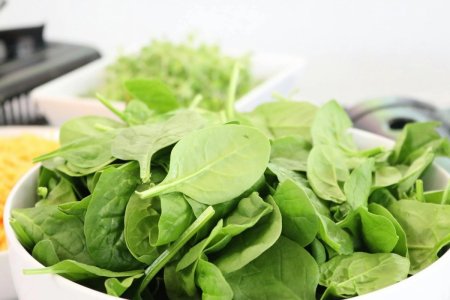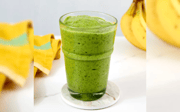Is spinach the superfood you’re missing? 6 ways it can boost your health today
By
Veronica E.
- Replies 0
Disclaimer: The information provided in this article is for educational purposes only and is not intended as a substitute for professional medical advice, diagnosis, or treatment. Always consult your physician or other qualified healthcare providers with any questions you may have regarding a medical condition or before making any changes to your health regimen.
If you grew up hearing that spinach builds strength, you weren’t wrong.
While it might not give you Popeye-level muscles on the spot, modern nutrition science confirms what many of us suspected all along—spinach is a true nutritional powerhouse.
It’s not flashy, and it doesn’t always get the spotlight, but behind its humble leaves lies a rich source of vitamins, minerals, and antioxidants that can support your health in meaningful ways.
From keeping your heart and eyes in good shape to helping with energy, digestion, and even managing weight, spinach works quietly behind the scenes to help you feel your best.
And in today’s world—where groceries cost more and convenience matters—spinach stands out as a simple, budget-friendly food that punches well above its weight.
At The GrayVine, we’re always on the lookout for foods that make eating well easier, especially for older adults who want meals that are both nourishing and enjoyable.

So if it’s been a while since you reached for a bunch of fresh greens, here are six surprising reasons to bring spinach back into your kitchen—and a few tips to make it easy and delicious.
1. Big Nutrition, Tiny Calorie Count
Trying to eat healthier or manage your weight? Spinach is your secret weapon.
Two cups of raw spinach contain just 14 calories, but they’re packed with more than 10% of your daily needs for vitamins A, C, and K, as well as folate, magnesium, and iron.
That means you can add volume and nutrients to your meals without worrying about your waistline.
It’s a win-win for anyone looking to eat more and weigh less!
2. Fills Nutritional Gaps—Especially for Iron, Magnesium, and Fiber
Many Americans—especially older adults—fall short on key nutrients like iron, magnesium, and fiber. Spinach is a delicious way to help fill those gaps:
3. May Help Protect Your Liver
Did you know that nearly a quarter of Americans have fatty liver disease, a condition linked to heart disease, diabetes, and liver inflammation?
Observational studies suggest that people who eat more spinach have a lower risk of developing fatty liver disease.
While more research is needed, it’s another great reason to pile those greens on your plate.
4. Heart Health Hero
Spinach is rich in natural nitrates, which your body converts into nitric oxide—a compound that helps relax and widen your blood vessels.
This can lead to lower blood pressure and more flexible arteries, both of which are crucial for heart health.
Some studies even suggest that a spinach-rich diet can help keep your ticker in top shape as you age.
Also read: Discover the "dinosaur time" trend that's helping people eat more greens
5. Supports Sharp Vision as You Age
Worried about your eyesight?
Spinach is loaded with lutein and zeaxanthin, two plant compounds that help protect your eyes from damaging blue light and may lower your risk of age-related macular degeneration (AMD)—a leading cause of vision loss in older adults.
In fact, people who eat spinach at least twice a week are up to 58% less likely to develop AMD than those who rarely eat it.
6. Fights Oxidative Stress and Inflammation
Spinach is brimming with antioxidants like quercetin, which help neutralize harmful free radicals in your body.
This can reduce inflammation and protect your cells from damage linked to chronic diseases like heart disease, diabetes, and even some cancers.
Also read: Triple the life of your produce with this simple post-supermarket trick you need to try!
How to Add More Spinach to Your Diet (Without Even Noticing!)
One of the best things about spinach is its mild flavor and tender texture.
Unlike kale or collard greens, spinach blends seamlessly into all kinds of dishes—no bitterness or toughness to contend with.
Here are a few easy ways to sneak more spinach into your meals:
A Few Cautions Before You Go All-In
While spinach is a nutritional superstar, there are a couple of things to keep in mind:
Need inspiration? Try these recipes:
Spinach may not have the trendy reputation of kale or microgreens, but it’s a classic for a reason.
It’s easy to find, easy to use, and packed with nutrients that support your heart, eyes, liver, and more.
Whether you’re a lifelong spinach lover or just warming up to the idea, there’s never been a better time to add more of this leafy green to your plate!
Read next: Are you iron-deficient? Discover 7 simple diet changes to boost your iron levels instantly!

Do you have a favorite spinach recipe or a creative way to sneak it into your meals? Have you noticed any health benefits since adding more greens to your diet? Share your tips, stories, and questions in the comments below—let’s inspire each other to eat well and feel our best!
If you grew up hearing that spinach builds strength, you weren’t wrong.
While it might not give you Popeye-level muscles on the spot, modern nutrition science confirms what many of us suspected all along—spinach is a true nutritional powerhouse.
It’s not flashy, and it doesn’t always get the spotlight, but behind its humble leaves lies a rich source of vitamins, minerals, and antioxidants that can support your health in meaningful ways.
From keeping your heart and eyes in good shape to helping with energy, digestion, and even managing weight, spinach works quietly behind the scenes to help you feel your best.
And in today’s world—where groceries cost more and convenience matters—spinach stands out as a simple, budget-friendly food that punches well above its weight.
At The GrayVine, we’re always on the lookout for foods that make eating well easier, especially for older adults who want meals that are both nourishing and enjoyable.

Fresh spinach leaves offer a simple, affordable way to boost your meals with essential vitamins and minerals. Image Source: Pexels / Jacqueline Howell.
So if it’s been a while since you reached for a bunch of fresh greens, here are six surprising reasons to bring spinach back into your kitchen—and a few tips to make it easy and delicious.
1. Big Nutrition, Tiny Calorie Count
Trying to eat healthier or manage your weight? Spinach is your secret weapon.
Two cups of raw spinach contain just 14 calories, but they’re packed with more than 10% of your daily needs for vitamins A, C, and K, as well as folate, magnesium, and iron.
That means you can add volume and nutrients to your meals without worrying about your waistline.
It’s a win-win for anyone looking to eat more and weigh less!
2. Fills Nutritional Gaps—Especially for Iron, Magnesium, and Fiber
Many Americans—especially older adults—fall short on key nutrients like iron, magnesium, and fiber. Spinach is a delicious way to help fill those gaps:
- Iron: Essential for carrying oxygen in your blood, iron is especially important for women and anyone who wants to keep their energy up.
- Magnesium: Supports bone health, muscle function, and even helps regulate blood sugar.
- Fiber: Keeps your digestive system humming, helps lower cholesterol, and may reduce your risk of colorectal cancer.
3. May Help Protect Your Liver
Did you know that nearly a quarter of Americans have fatty liver disease, a condition linked to heart disease, diabetes, and liver inflammation?
Observational studies suggest that people who eat more spinach have a lower risk of developing fatty liver disease.
While more research is needed, it’s another great reason to pile those greens on your plate.
4. Heart Health Hero
Spinach is rich in natural nitrates, which your body converts into nitric oxide—a compound that helps relax and widen your blood vessels.
This can lead to lower blood pressure and more flexible arteries, both of which are crucial for heart health.
Some studies even suggest that a spinach-rich diet can help keep your ticker in top shape as you age.
Also read: Discover the "dinosaur time" trend that's helping people eat more greens
5. Supports Sharp Vision as You Age
Worried about your eyesight?
Spinach is loaded with lutein and zeaxanthin, two plant compounds that help protect your eyes from damaging blue light and may lower your risk of age-related macular degeneration (AMD)—a leading cause of vision loss in older adults.
In fact, people who eat spinach at least twice a week are up to 58% less likely to develop AMD than those who rarely eat it.
6. Fights Oxidative Stress and Inflammation
Spinach is brimming with antioxidants like quercetin, which help neutralize harmful free radicals in your body.
This can reduce inflammation and protect your cells from damage linked to chronic diseases like heart disease, diabetes, and even some cancers.
Also read: Triple the life of your produce with this simple post-supermarket trick you need to try!
How to Add More Spinach to Your Diet (Without Even Noticing!)
One of the best things about spinach is its mild flavor and tender texture.
Unlike kale or collard greens, spinach blends seamlessly into all kinds of dishes—no bitterness or toughness to contend with.
Here are a few easy ways to sneak more spinach into your meals:
- Smoothies: Toss a handful of fresh spinach into your morning smoothie. You’ll barely taste it, but your body will thank you.
- Soups and Stews: Stir chopped spinach into soups, stews, or chili just before serving.
- Egg Dishes: Add spinach to omelets, frittatas, or scrambled eggs for a nutrient boost.
- Pasta and Sauces: Mix spinach into pasta sauces, lasagna, or even meatballs.
- Baked Goods: Believe it or not, spinach can be blended into muffins or quick breads for extra nutrition.
A Few Cautions Before You Go All-In
While spinach is a nutritional superstar, there are a couple of things to keep in mind:
- Kidney Stones: Spinach is high in oxalates, which can contribute to kidney stones in people who are prone to them. If you have a history of kidney stones, talk to your doctor about how much spinach is safe for you.
- Blood Thinners: Spinach is rich in vitamin K, which can interfere with certain blood-thinning medications. If you’re on a blood thinner, check with your healthcare provider before making big changes to your spinach intake.
Need inspiration? Try these recipes:
- Skillet Spinach Lasagna
- Spinach & Cheese Breakfast Skillet
- Spinach-Stuffed Flounder with Mushrooms and Feta
- Creamy Gnocchi with Spinach and Sausage
- Cheesy Spinach & Artichoke Dip
- Curried Brown Rice with Pumpkin Seeds, Apricots and Spinach
Spinach may not have the trendy reputation of kale or microgreens, but it’s a classic for a reason.
It’s easy to find, easy to use, and packed with nutrients that support your heart, eyes, liver, and more.
Whether you’re a lifelong spinach lover or just warming up to the idea, there’s never been a better time to add more of this leafy green to your plate!
Read next: Are you iron-deficient? Discover 7 simple diet changes to boost your iron levels instantly!
Key Takeaways
- Spinach is a convenient, affordable, and versatile leafy green that offers impressive nutritional benefits, including vitamins A, C, and K, folate, magnesium, iron, and fiber.
- Consuming spinach may support heart health, reduce the risk of fatty liver disease, help protect against age-related macular degeneration, and guard against oxidative damage.
- Research suggests that a spinach-rich diet can assist with weight management due to its low calorie count and high nutrient density, and its plant compounds contribute to various health benefits.
- While spinach is generally beneficial, people with a history of kidney stones or those taking blood-thinning medication should be cautious with their intake because of its high oxalate and vitamin K content.
Do you have a favorite spinach recipe or a creative way to sneak it into your meals? Have you noticed any health benefits since adding more greens to your diet? Share your tips, stories, and questions in the comments below—let’s inspire each other to eat well and feel our best!






